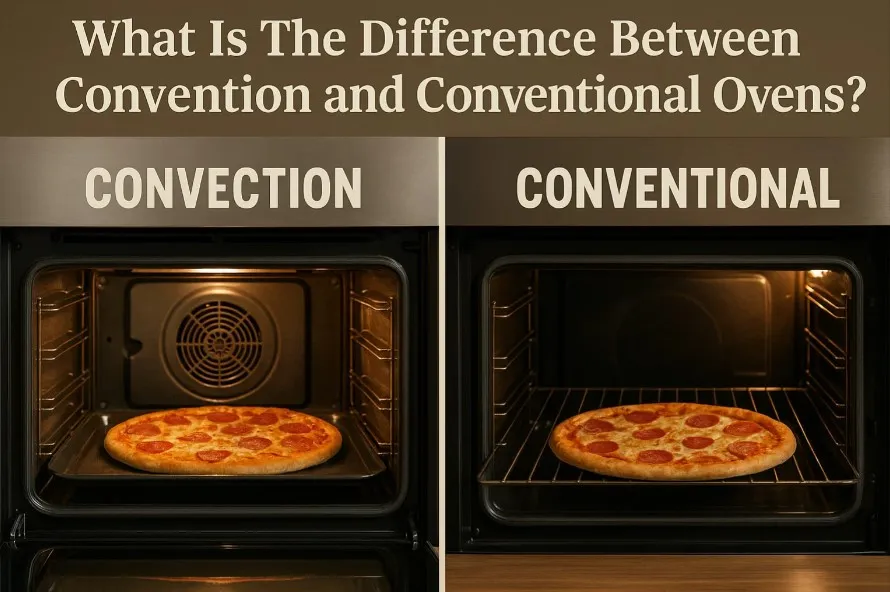The main difference is that convection ovens have a fan and exhaust system to circulate hot air, cooking food faster and more evenly, while conventional ovens use still heat, which can lead to hot spots but is better for delicate baking.
When I first learned about ovens, I was surprised. Convection ovens and conventional ovens work in very different ways. Convection ovens use a fan to blow hot air around, which helps food cook evenly. In contrast, conventional ovens heat from one spot, and heat rises naturally, leading to less even cooking.
A significant difference between convection and conventional ovens is how much energy they use. Convection ovens save about 30% more energy than conventional ovens. The moving air cooks food faster and at lower temperatures, making convection ovens cheaper and more efficient. Choosing the right oven depends on what you cook and how you prefer it.
Important Facts
- Convection ovens have a fan that moves hot air around. This cooks food faster and more evenly than regular ovens.
- For convection ovens, lower the recipe temperature by 25°F. Also, reduce the cooking time by 25%.
- Convection ovens use about 30% less energy than regular ovens. This can help you save money on electricity.
- They are great for foods that need even cooking. Use them for roasted veggies or baked treats. Avoid them for fragile dishes like soufflés.
- Regular ovens are simpler to use with most recipes. They work well for slow-cooking and gentle baking.
“A convection oven is like having a little windstorm inside your oven—it cooks food faster and more evenly.” – Alton Brown
How convection and conventional ovens work
How convection ovens distribute heat
When I first tried a convection oven, I saw food cooked faster and more evenly. This happens because a fan moves hot air around the food. The fan spins quickly, about 1300 times per minute, and its blades help push air better. This airflow makes the layer of air around the food thinner. That layer usually slows cooking, but with less of it, heat reaches the food faster. This helps the food cook evenly and quicker.
Convection ovens also use lower temperatures. For example, I lower the heat by about 36 °F (20 °C) compared to regular oven recipes. This keeps food from overcooking and keeps its flavor and texture. The even heat is great for roasting meat or baking pastries. It removes hot spots, so everything cooks the same way.
Here’s a simple look at how convection ovens work:
| Aspect | Explanation |
|---|---|
| Heat Distribution | Hot air moves around, cooking food evenly. |
| Thermal Boundary Layer Reduction | The fan thins the air layer, making heat transfer faster. |
| Cooking Temperature Adjustment | Recipes need about 36 °F (20 °C) lower temperatures. |
How conventional ovens generate heat
Conventional ovens work differently. They use heat from fixed heating parts, usually at the top and bottom. When I use one, I notice the heat rises, making the top hotter than the bottom. This uneven heat can make food cook differently, like baked goods not turning out right.
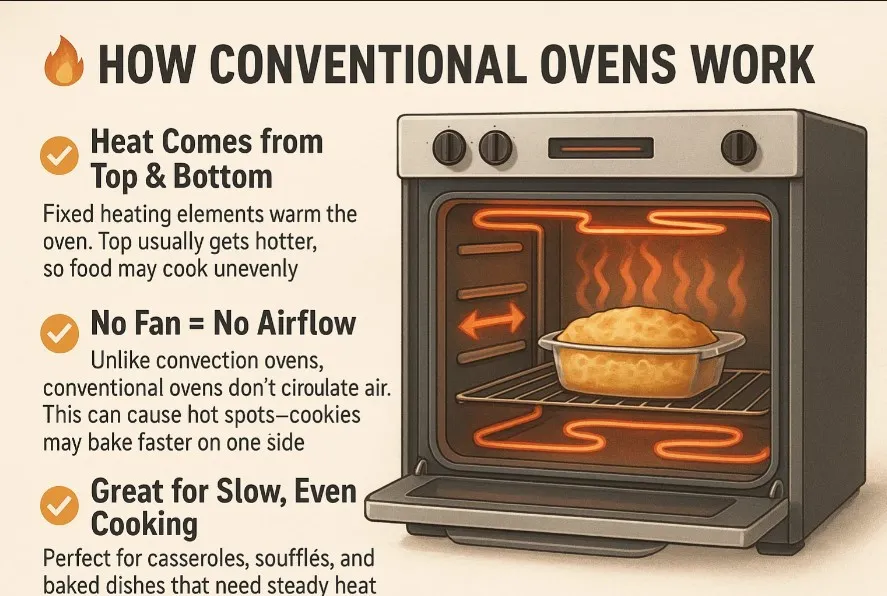
Unlike convection ovens, conventional ovens don’t have a fan to move air. The heat stays still, which can create hot spots. For example, cookies might bake faster on one side of the tray. But these ovens are good for recipes needing slow, steady heat, like casseroles or soufflés.
Here’s a quick comparison of convection and conventional ovens:
| Feature | Convection Ovens | Conventional Ovens |
|---|---|---|
| Heating Mechanism | Uses a fan to move hot air. | Uses heat from fixed heating parts. |
| Cooking Time & Efficiency | Cooks faster with moving air. | Takes longer without air movement. |
| Cooking Consistency | Cooks evenly and avoids hot spots. | Can cook unevenly due to still heat. |
| Temperature Management | Needs recipe changes for lower heat. | Recipes are easier to follow without changes. |
The main difference is how they heat food. Convection ovens cook evenly, while conventional ovens are better for recipes needing steady heat.
Key differences between convection and conventional ovens
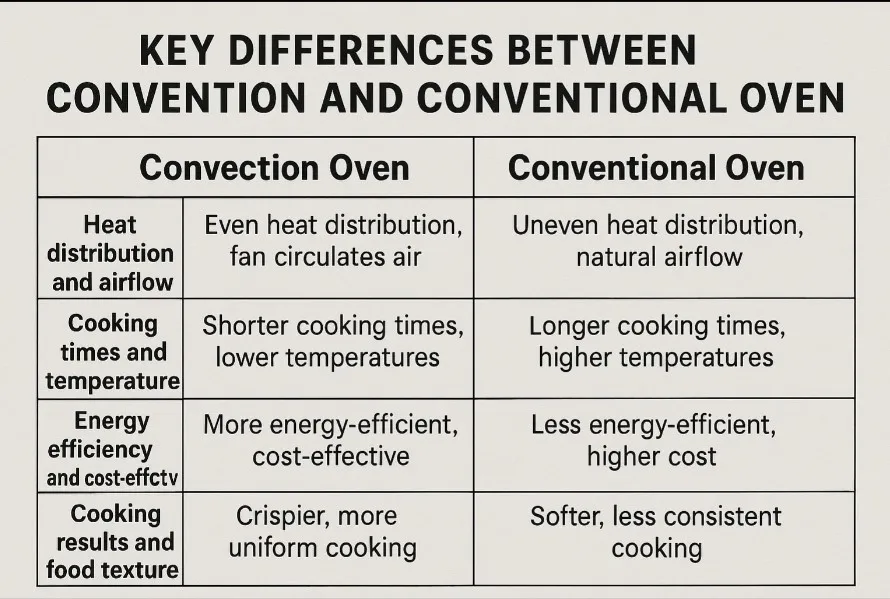
Heat distribution and airflow
The way heat spreads is a big difference between these ovens. Conventional ovens use fixed heat sources, usually at the top or bottom. This makes heat rise naturally, which can cause uneven cooking. For example, cookies might brown more on one side of the tray.
In contrast, convection ovens have a fan that moves hot air around. This helps heat reach all parts of the food evenly. It’s great for roasting vegetables or baking multiple trays at once. The fan also reduces hot and cold spots, so I don’t need to rotate pans often. Studies show convection ovens keep temperatures steady, which is important for delicate dishes like soufflés.
Here’s a simple comparison of heat distribution:
- Conventional ovens: Heat stays still, leading to uneven cooking.
- Convection ovens: A fan moves air, creating even heat and fewer hot spots.
Cooking times and temperature adjustments
Cooking time and temperature are also different for these ovens. Conventional ovens take longer because the heat doesn’t move. For example, lasagna might take an hour to cook. Convection ovens, however, cook faster since the moving air speeds up heat transfer. I usually save about 25% of the cooking time.
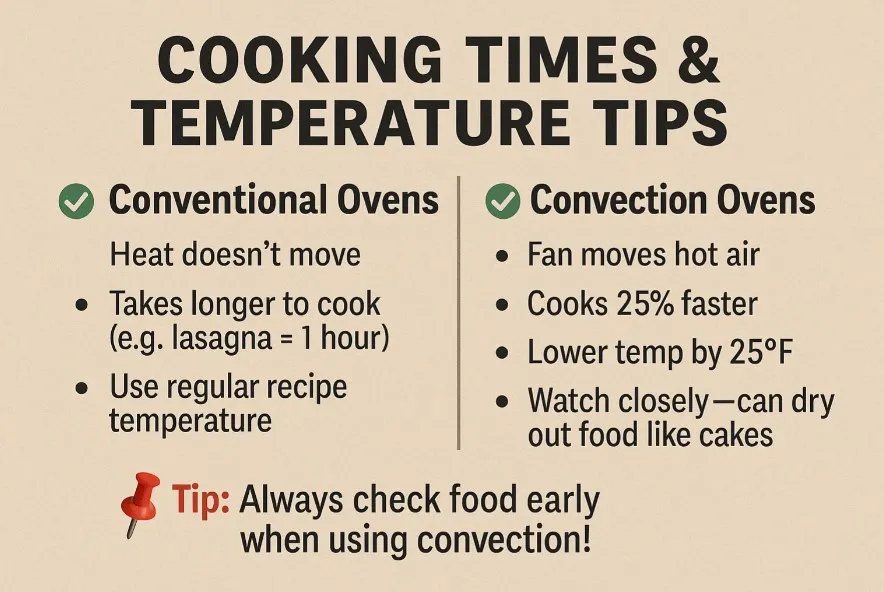
Temperature changes are also needed for convection ovens. Recipes for conventional ovens often need adjustments. I lower the temperature by 25°F when using a convection oven. Research shows convection ovens cook faster but can dry out food if not watched closely. Cakes, for instance, may rise more but turn out drier.
Here’s a quick look at cooking times and temperatures:
- Conventional ovens: Longer cooking times with standard recipe temperatures.
- Convection ovens: Faster cooking and lower temperatures to avoid overcooking.
Energy efficiency and cost-effectiveness
Convection ovens are more energy-efficient. They cook faster and at lower temperatures, saving energy. Studies say they use up to 30% less energy than conventional ovens. This lowers electricity bills and is better for the environment.
Conventional ovens use more energy because they need higher heat and longer times. For example, roasting a chicken takes 90 minutes at 375°F in a conventional oven. In a convection oven, it takes just over an hour at 350°F. This saves both time and money.
Here’s a summary of energy use:
- Conventional ovens: Use more energy due to longer times and higher heat.
- Convection ovens: Save energy by cooking faster and at lower heat.
Knowing these differences helps me pick the right oven for each recipe. Whether baking, roasting, or reheating, understanding how they work gives better results.
“The secret to great cooking is knowing your tools—convection ovens are a game-changer for even baking.” – Ina Garten
Cooking results and food texture
When comparing convection and conventional ovens, the results differ a lot. Convection ovens cook food evenly with consistent textures. The fan moves hot air, so heat reaches all parts. For example, roasted vegetables turn golden and crispy outside but stay soft inside. This even cooking is also great for baking cookies or pastries. Every piece bakes the same, with no raw centers or burnt edges.
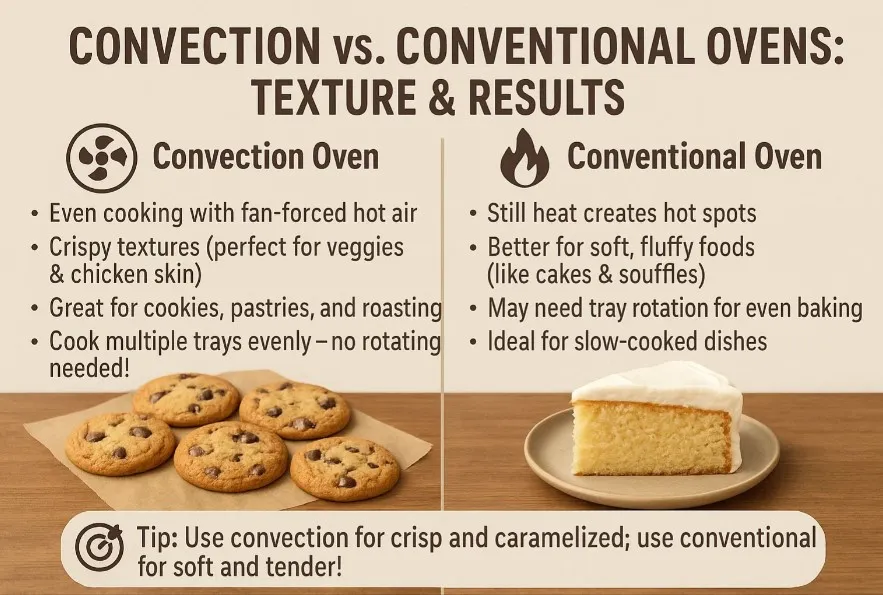
Conventional ovens, however, often cook unevenly. Without moving air, heat stays in one place. For instance, cakes might brown on top before the middle is done. This uneven heat can cause dry or overcooked spots. But conventional ovens are better for slow-cooking recipes. Foods like casseroles or soufflés need steady heat to cook fully without drying out.
The food texture also changes between these ovens. Convection ovens are best for crispy textures. The fan removes surface moisture, making chicken skin crispy. They’re also great for caramelizing sugars, like roasting nuts or browning casseroles. Conventional ovens work better for soft textures. I use them for fluffy cakes or bread. The still heat helps batter rise evenly without drying the top.
Cooking multiple dishes shows the biggest difference. In a convection oven, two trays of cookies bake evenly at once. In a conventional oven, the tray near the heat cooks faster. I have to rotate trays halfway through. This makes convection ovens easier for big meals or batch cooking.
Pros and cons of convection ovens
Benefits of using convection ovens
Convection ovens have changed how I cook food. They spread hot air evenly, making cooking results consistent. When I bake cookies, they all turn golden without burnt edges. This even heat means I don’t need to move trays around.
These ovens also save time by cooking food faster. The moving air helps heat reach food quickly. For example, roasting a chicken takes 25% less time than in a conventional oven. This is helpful when I’m busy and need meals quickly.
Convection ovens are also very flexible. They’re great for roasting, baking, and even drying food. I’ve used mine to roast vegetables, bake pastries, and make dried fruit. The fan removes moisture, creating crispy textures that are hard to get with other ovens.
Here’s a simple list of the benefits:
- Even cooking: Hot air moves, so no hot spots.
- Time-saving: Food cooks faster, saving time.
- Versatility: Works well for roasting, baking, and drying.
- Energy efficiency: Uses less energy with lower heat and shorter times.
Tip: Use convection ovens for crispy foods like roasted meats or baked treats. Avoid them for delicate dishes like soufflés that need steady heat.
Limitations of convection ovens
Convection ovens also have some downsides. One problem is changing recipes. Most recipes are made for regular ovens, so I lower the heat by 25°F or cook for less time. If I don’t adjust, food might overcook or dry out.
Taking care of these ovens can be tricky. Some models need special maintenance. A kitchen manager once said, “Combi ovens are hard to fix and cost a lot to repair.” Fixing them takes time and skilled workers, which can be expensive.
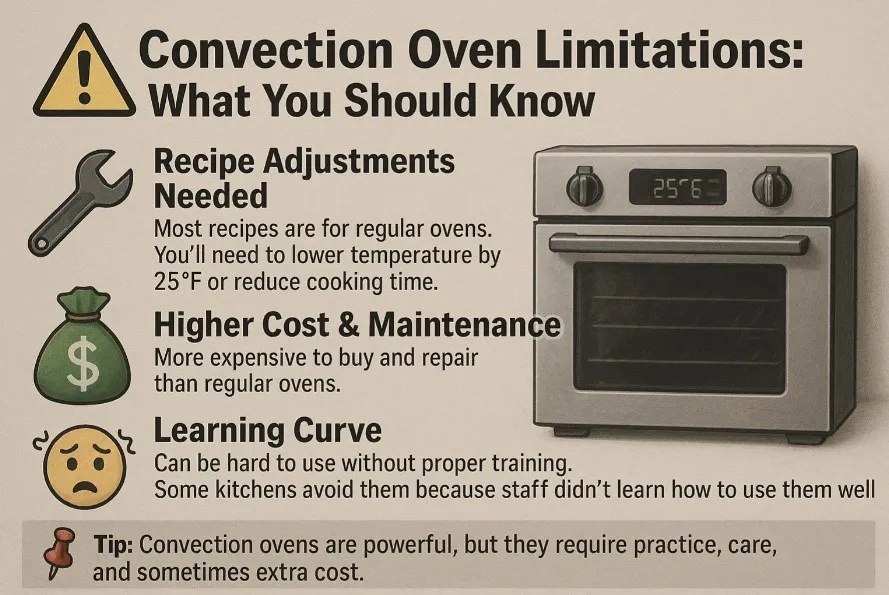
Buying a convection oven can also cost a lot. Single-deck models are pricey, which might not work for small kitchens or families. Plus, running them adds to electricity and repair costs.
Sometimes, learning to use these ovens is hard. In Mississippi schools, staff had trouble using steam and convection ovens. They didn’t get enough training, so the ovens weren’t used much. This made them less useful.
Here’s a quick look at the downsides:
| Limitation | Details |
|---|---|
| Recipe Adjustments | Needs changes to heat and cooking time. |
| Maintenance Challenges | Repairs are costly and need skilled workers. |
| High Costs | Buying and running them can be expensive. |
| Training Requirements | Staff may need extra training to use them. |
Note: If you want a convection oven, think about repair costs and recipe changes. Training can help you use it better.
Pros and cons of conventional ovens
Advantages of conventional ovens
Conventional ovens have been used in kitchens for years. They are simple and easy to use. You don’t need to change recipes or adjust temperatures. Standard recipes work perfectly without extra steps. This makes them great for dishes like casseroles or cakes.
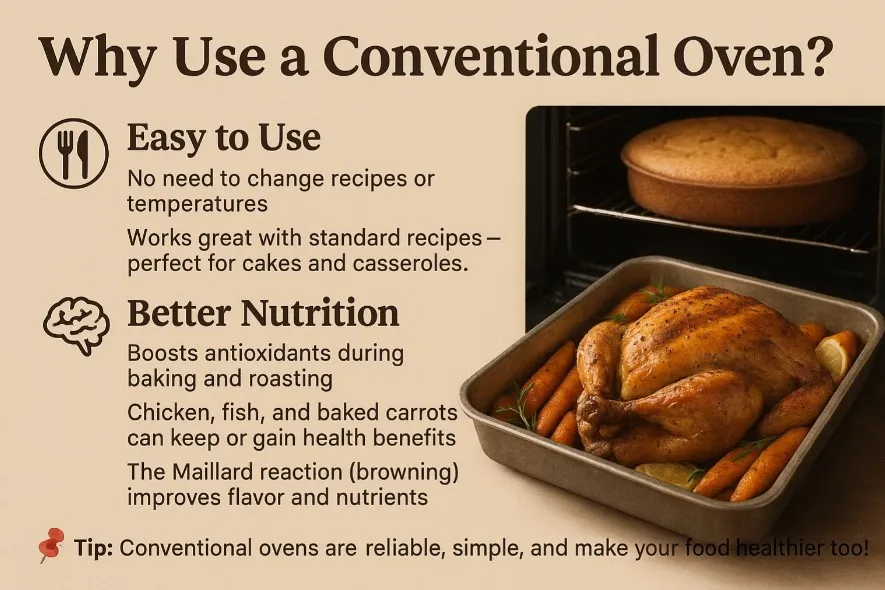
Another benefit is how they improve food’s flavor and nutrients. Cooking in these ovens can boost antioxidants in food. For example:
- Baking or roasting causes the Maillard reaction, which increases antioxidants.
- Foods like chicken and fish keep or even gain antioxidants when cooked.
- Baked carrots balance nutrient loss while releasing more antioxidants.
I also like the steady heat these ovens provide. This is perfect for delicate recipes like soufflés or sponge cakes. Small temperature changes can ruin these dishes, so steady heat is important.
Tip: Use a conventional oven for slow-cooking recipes or to keep natural flavors in your food.
Drawbacks of conventional ovens
Conventional ovens have some downsides. Uneven heating is a common problem. I often rotate trays or move racks to cook food evenly. The bottom rack cooks faster because it’s closer to the heat. The middle rack takes longer. This makes baking multiple trays or large meals harder.
These ovens are also less efficient than convection ovens. They need higher heat and longer cooking times. For example, roasting a chicken takes 90 minutes at 375°F. A convection oven cooks it faster and at a lower temperature, saving time and energy.
Here’s a quick comparison:
- Conventional ovens: Heat stays still, causing uneven cooking on different racks.
- Convection ovens: Hot air moves, cooking food evenly without rotating trays.
While I like using a conventional oven for some recipes, I’ve learned to manage its issues. I monitor food closely and adjust rack positions as needed.
Note: If you’re cooking many dishes or want faster results, a convection oven might be better. Conventional ovens are best for recipes needing steady heat and precision.
Tips for using convection ovens effectively
Adjusting recipes for convection settings
When I began using a convection oven, I noticed recipes needed changes. The moving air cooks food faster, so I lower the heat by 25°F. For example, if a recipe says 375°F, I set it to 350°F. I also cut cooking time by about 25%. If a casserole takes 60 minutes in a conventional oven, I check it after 45 minutes in the convection oven.
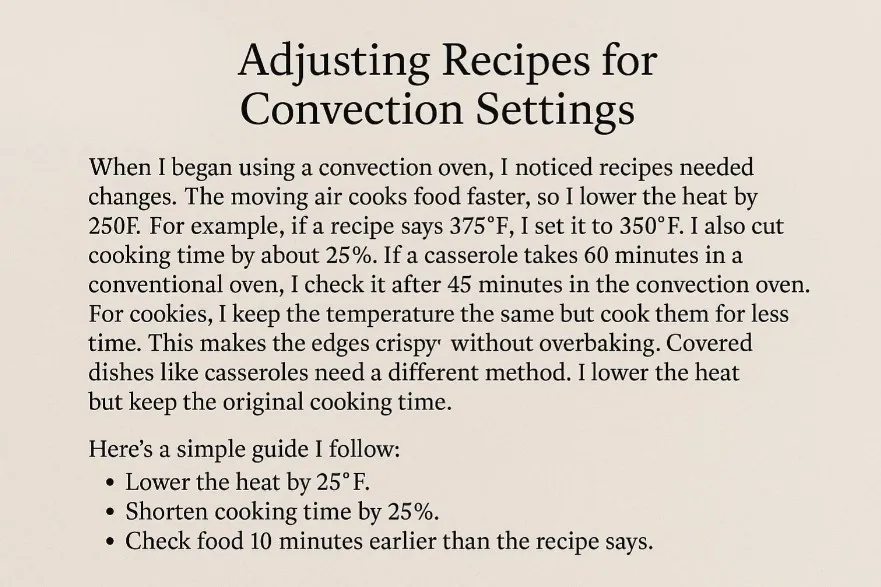
For cookies, I keep the temperature the same but cook them for less time. This makes the edges crispy without overbaking. Covered dishes like casseroles need a different method. I lower the heat but keep the original cooking time for even cooking.
Here’s a simple guide I follow:
- Lower the heat by 25°F.
- Shorten cooking time by 25%.
- Check food 10 minutes earlier than the recipe says.
- Keep the heat the same for crispy edges but cook less time.
Tip: Watch your food closely with convection settings. It’s better to check early than overcook.
Foods that work best in convection ovens
Some foods are great in convection ovens. Roasted vegetables are my favorite. The hot air makes them crispy outside and soft inside. Cookies and pastries also bake evenly. They come out perfect, with no burnt edges or raw spots.
Meats like chicken and turkey roast well in these ovens. The air crisps the skin while keeping the meat juicy. I also use my oven to dry fruits and herbs. The fan removes moisture quickly, making it great for dehydrating.
Here’s a list of foods that work well:
- Roasted vegetables for crispy outsides.
- Cookies and pastries for even baking.
- Meats like chicken and turkey for juicy centers and crispy skin.
- Fruits and herbs for drying and saving.
Note: Convection ovens are ideal for foods needing even heat and crispy textures.
When to avoid using convection settings
Not all recipes work in convection ovens. I skip the fan for delicate desserts like custards, flans, and soufflés. The moving air can ruin their shape, making them collapse or cook unevenly. Cream puffs are also tricky. Chef Mattel says not to use convection settings for these light treats.
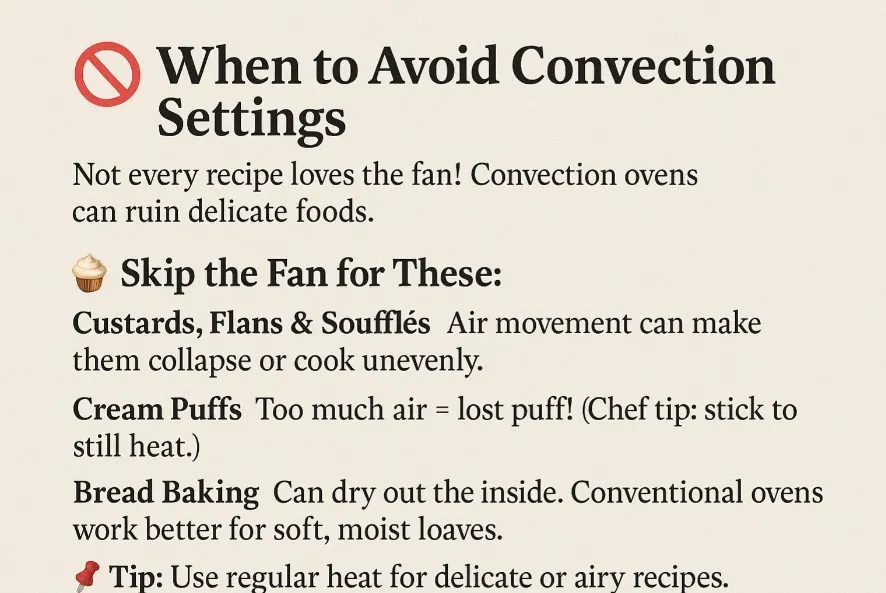
Bread baking is another debated topic. Some bakers say convection ovens dry out bread, while others adjust recipes successfully. I prefer a conventional oven for bread to avoid texture problems.
Here’s when I avoid convection settings:
- Custards, flans, and soufflés to keep their delicate shape.
- Cream puffs to protect their airy texture.
- Bread baking to stop the inside from drying out.
Tip: Use conventional settings for recipes needing steady heat to keep their texture and shape.
Comparing convection and conventional ovens shows clear differences. Convection ovens cook faster and more evenly. They are great for roasting veggies or baking treats. Conventional ovens work better for traditional recipes. They are ideal for delicate baking like soufflés or sponge cakes. Picking the right oven depends on your cooking habits and budget. Think about what you cook most often before choosing the best oven for you.
“Good food starts with the right equipment—choose an oven that fits your cooking style.” – Gordon Ramsay
Frequently Asked Questions For Difference Between Convection and Conventional Ovens
Can I use aluminum foil in a convection oven?
Yes, but be careful. Don’t block the airflow. Avoid wrapping food too tightly or covering racks fully. Use foil for lining trays or wrapping food. Always leave space for air to move around freely.
Do convection ovens cook faster than conventional ovens?
Yes, they do! Convection ovens are about 25% faster. The fan moves hot air, which speeds up cooking. I save time roasting meats or baking cookies. Lowering the temperature helps avoid overcooking.
Are convection ovens better for baking cakes?
Not always. I like conventional ovens for soft cakes like sponge or chiffon. Convection ovens can dry batter or make cakes rise unevenly. For dense cakes like pound cake, convection works with recipe changes.
What foods should I avoid cooking in a convection oven?
I don’t use convection for custards, soufflés, or cream puffs. These need steady heat to keep their texture. Moving air can ruin their structure. I also avoid baking bread unless I adjust the recipe.
How do I clean a convection oven fan?
First, turn off and unplug the oven. Use a soft brush or cloth to clean dust and grease from the fan. For tough grime, use warm water and mild soap. Cleaning often keeps the fan working well.
Conclusion
Understanding the difference between convection and conventional ovens helps you make smarter cooking decisions. While conventional ovens are great for traditional baking, convection ovens offer speed and precision. Consider your cooking habits, budget, and kitchen needs before making a choice.

